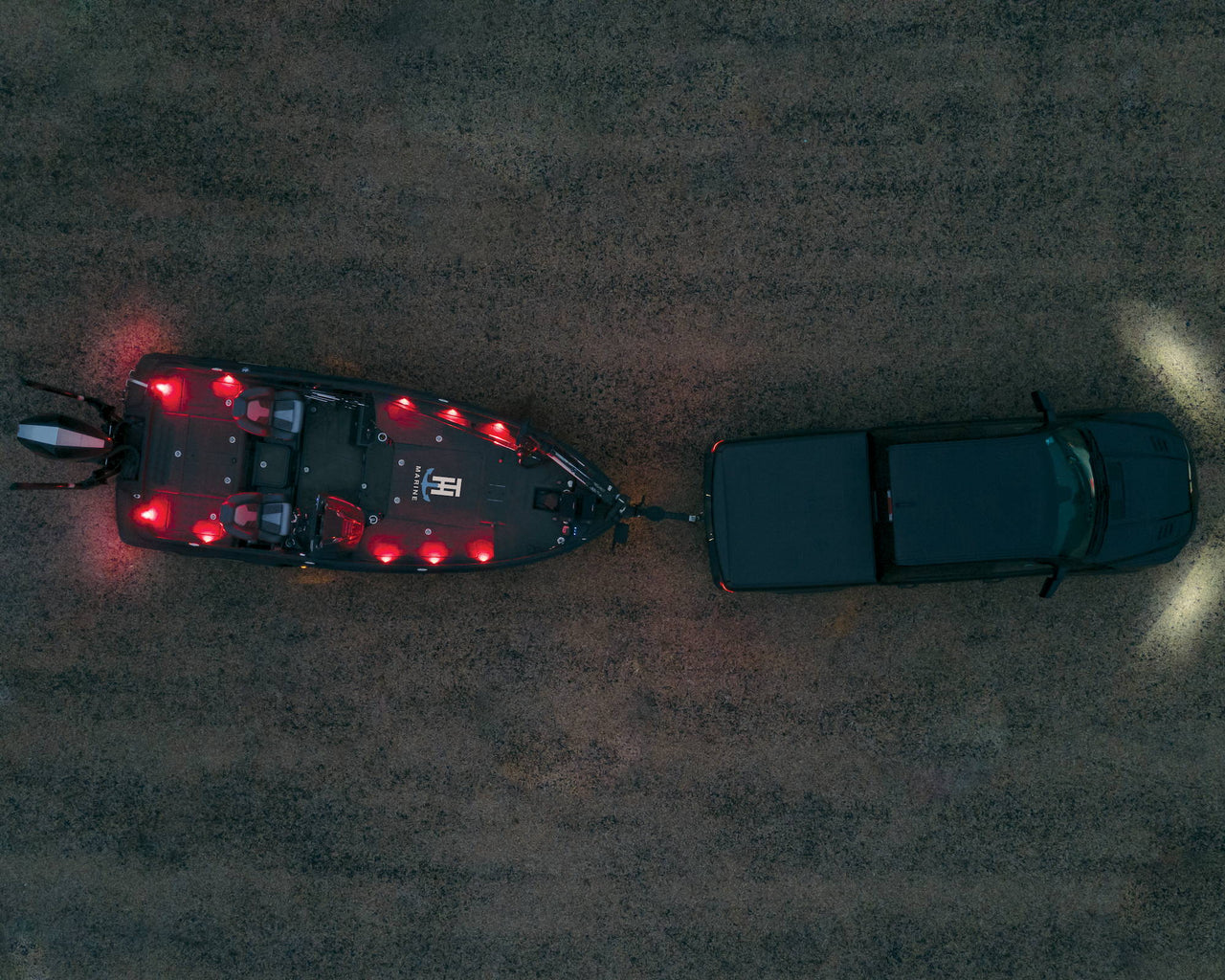If you’ve been wanting to upgrade the lighting on your boat, but you need a bit of help with knowing how to do it, LED deck lights are a great place to start. Check out the step by step guide and video below and you’ll know just what to do to give your boat better lines of sight and an impressive look.

How to Install LED Deck Lights on a Boat
For this project, we used Blue Water LED Extreme Pro Deck Lights, which are available as single lights and as multi-light deck kits. We used these because they provide a great amount of light for tying baits, unhooking fish, adding light along edges within a boat, and much more. They’re also low profile, easy to install, and have a low power draw.
This install utilized red lights, but there are several other color options as well. All come with the necessary hardware mentioned in the steps below.
Step 1: Prepping to Begin Install
Like any project, the first thing you want to do is review what you’ll need for the job and get things ready. For this job, there are a variety of common tools and supplies you'll need to ensure a successful installation.
Supplies and Tools for the Job
-
Tape Measure
-
Marker / lumber crayon
-
Drill
-
Hole saw
-
Drill bit
-
Countersink bit
- Electrical tape
-
Pliers
-
Wire strippers
-
Fish tape
-
Lighter / Heat Gun
-
Screw driver
-
Box cutter
Battery Prep — Disconnect It
You’ll want to disconnect the battery or batteries running power to your boat. This keeps both you and your equipment safe should any wiring work go different than planned.
Scoping Out Where You’re Connecting Wires
At a minimum, your led deck lights will need connections for their power source, their negative wiring, and their ability to be toggled on or off. Look over your boat for the options below so wiring goes as smoothly as possible.
Tapping Into Existing Lights
If you elect to install your new lights by tapping into existing ones, you won't have to run as much wire through your boat and you can avoid installing a new switch. It’s not only easier to do this, but it’s a good way to tie into other lights that you’ll want running at the same time.
Tapping Into an Existing Accessory Switch
Many boats will have an empty accessory switch, so if you need to run these lights separate from what may already be wired in, you can tap into that accessory switch. It requires running more wire, but that existing switch makes it a bit easier and affords you separate control.
Installing a New Switch
Your boat will probably have a good spot around the console for installing a switch and your typical switch will only require clearance for the switch and wiring as well as a hole for the switch to mount through. If you've located where you'd install the switch, you'll just need to identify the route where you'll run your wire to it.
Step 2: Planning Where LED Deck Lights Will Go
Since many boats will have some basic interior lights that are already controlled by a switch, this install starts there. Here’s how to plan out where the lights will go.
-
Unpackage lights, mounting hardware, and rubber mounting backers
-
Check how flat your mounting surfaces are to inform your choice between flat mounting backers or curved ones
-
Locate the nearest existing lights and wiring that you can tap into
-
Rest your lights on the deck next to the spots where you want to install them
-
Determine if you can install the lights symmetrically between the port and starboard sides
-
Find points of reference to help you line up the lights (especially when installing symmetrically). This may mean measuring the distance from existing lights, railing, cleats, spots where deck sections meet, etc
-
Minimize how lights may be covered up or diminished by what you have in your boat. In particular, consider how hatches open, where you'll be putting gear, and what else you're rigging in the boat
-
Measure the light's vertical positioning and horizontal positioning (and double-check it) to be sure it's right where you want it and make your mark
-
Repeat for each light you have and you can get a nice look at where all the lights will be placed before you make any permanent alterations to your boat
Step 3: Safely Cutting Holes in Your Boat
Cutting holes in your boat is no small deal, but it doesn’t need to be impossibly intimidating either. When you follow best practices like those outlined below, you can do it right and avoid a number of unintended consequences.
-
Get a feel for any existing wiring that may be at risk when you drill — you can do this by opening adjacent compartments and reaching your arm up into the gunwale
-
Equip your drill with a hole saw bit, one that's large enough to give you a little working room for wires and connectors but small enough to be covered by the light and its mount
-
Start drilling slowly to secure your spot and center the bit on the mark, then increase speed while maintaining control
-
Repeat for each LED deck light location you’ve marked
Step 4: Wiring Prep Work
With your lights, wire strippers, electrical tape, and wire connectors ready, it's time to begin wiring your lights.
-
Feed the LED light’s wiring through the LED mounting backer piece before connecting anything else, so the mount and light are matched up correctly and ready to mount when the wiring is connected
-
Consider whether you'll have enough wire coming from each light to reach where it's tapping in
-
Skip ahead to Step 5 if you have enough wire to run it to where you'll splice it with the first light / tap-in point
-
If you don’t have a long enough length of wire on the LED light to reach the first light or tap-in point, snip some of the slack on the lights — you only need about 10 inches of the wire, so you have just enough to work with near the light and so your connection to the longer length of wire isn’t buried in the gunwale
-
Measure the wire you’re adding to get the length needed between the LED light's wire and where you'll be splicing it in (or unspool red and black wire simultaneously to the length needed, snip it, and tape the wires together)
Step 5: Preparing to Feed Wires Through the Gunwale to the Tap-In Point
With your lights, wire strippers, electrical tape, and wire connectors ready, it's time to connect wires and lights following one of the two processes detailed here.
Connecting Additional Wire
If you need to connect additional wire to cover the distance between the new hole and the tap-in point, follow the process below. Otherwise, proceed to using your fish tape and running your wiring to the tap-in point.
-
Strip about 1/4" of each wire's insulation (as needed) if you’re connecting additional wire to cover the distance to the tap-in point
-
Match up the red wire coming from the light to the red wire from the extra wire spool
-
Crimp your heat shrink connectors onto them (typically one wire on one side and the other wire on the other side) so they are connected
-
Repeat this for the black wires
-
Use a lighter or heat gun to apply heat to the connectors so the plastic around them shrinks and seals
-
Tightly wrap electrical tape around these connections so they are bundled together and secure if rattled or pulled
Using Fish Tape and Running Wire
This process outlines how to effectively run your wire between the new hole you drilled and the tap-in point.
-
Unroll fish tape from the spool, starting where you’ll be tapping into existing wiring and start to feed it through the gunwale to the hole you drilled (or repeat this process a few times if you’re running wire up to a switch panel)
-
Reach up into an adjacent storage compartment(s) to help guide it along to and through the hole you drilled
-
Take the leading edge of your LED wires and use electrical tape it to tightly secure them alongside a few inches of the fish tape
-
Feed the fish tape back through the new hole and pull it back to the previous hole or tap-in point
-
Free the leading edge of the wire from the fish tape and discard the electrical tape
Step 6: Connecting to Power and Negative Wires
After you've fed your wire to where you need it, it’s time to connect to either the switch or, in the case outlined in the steps below, to existing wiring that you’re tapping into and the next light in the series on your way back toward the switch.
-
Feed your next LED light’s wiring through the LED mounting backer piece before doing anything else, so the mount and light are matched up correctly and ready to mount when the wiring is connected
-
Set that next light and its wire nearby for when you need it later
-
Match up the wires you fed through the gunwale — black (negative) wire matched with and the boat’s existing negative wire you’re connecting it, then twist them into a pigtail
-
Repeat this step for the red / power wires
-
Slide a heat shrink butt splice onto these wires you’ve twisted together — one butt splice for the negative wires and one for the power wires
-
Crimp the side of the splice that holds that pigtail on the negative wires and crimp the butt splice the same way for the power wires
-
Match up your LED wires to the matching ones that are already crimped into the butt splices
-
Crimp the LED's wires in, heat shrink the splice, and wrap it with electrical tape
Step 7: Testing LED Deck Lights and Mounting Them
Before drilling holes for the mounting hardware, you’ll want to test them.
-
Double check your wire connections and switch, then reconnect your battery
-
Make sure each light is on and colored as expected
-
Repeat each of these steps for each of the new lights you connect
If all is good, you’re now ready to mount the lights using the included hardware.
-
Put your hole saw away and fit your drill with a standard bit that is just a little narrower in diameter than the threads on the screws you'll be using to secure the lights
-
Hold your led deck light in place, level as you can get it, and mark where you'll be drilling the holes for the screws
-
If you have existing holes from old lights, check to see if they are compatible with the screws on the new lights and see if you can use at least one of them to secure the new lights
-
Drill the screw holes with the standard drill bit
-
Countersink the screw holes slightly to prevent fiberglass and gel coat chipping and flaking
-
Brush off the mounting spot and fasten the screws for each light
With that, you’re all set and ready to enjoy the way these lights help you see and be seen!
Illumination + Imagination
If you have some bright ideas for your boat, we can help. All it takes is confidence, know-how, and top-of-the-line lights available from Blue Water LED.






